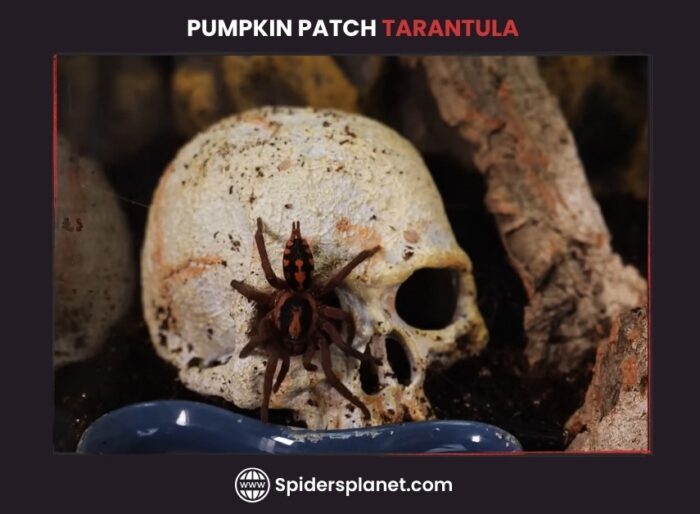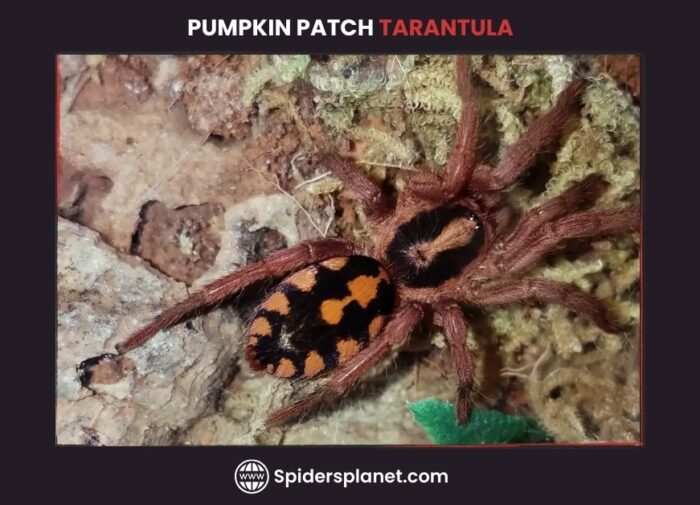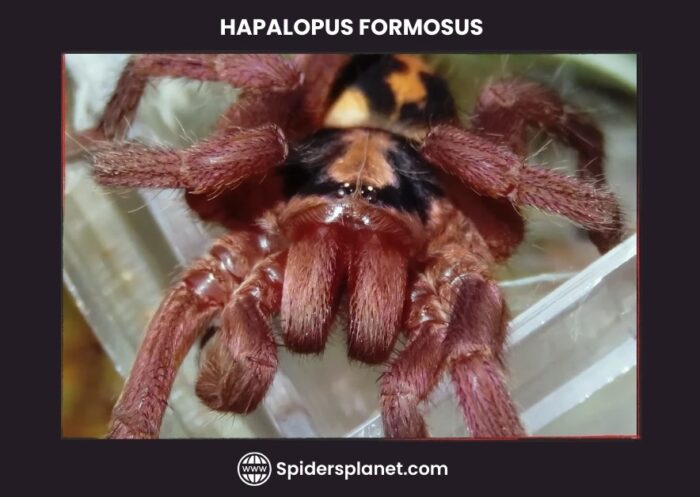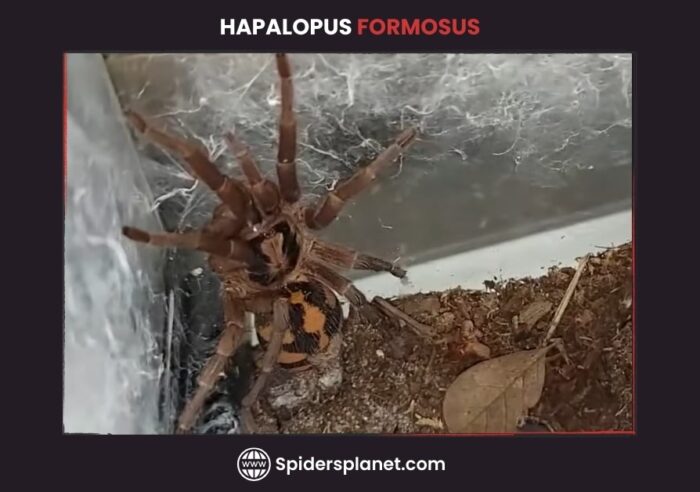The Pumpkin Patch Tarantula or Hapalopus formosus or Hapalopus sp. Colombia is a unique and colorful spider from Colombia. With its bright orange and black colors, it looks like a tiny pumpkin patch on eight legs!
These little tarantulas are about 2-3 inches long, and they are great for people who are new to keeping spiders as pets.
Even though they are usually calm, Pumpkin Patch Tarantulas can be fast and a bit jumpy, so it is important to handle them gently.

They have special hairs to flick off if they feel threatened, but do not worry; these tarantulas won’t hurt you, but they might make your skin a bit itchy.
Caring for these spiders may seem a little challenging initially, but armed with the correct knowledge, they transform into captivating and vibrant companions!
Let’s dive into understanding how to care for this small spider as a pet, exploring aspects such as its appearance, habits, habitat, diet, life cycle, and facts. Keep reading….!
Interesting Facts About Pumpkin Patch Tarantula
- They are classified as dwarf tarantulas because of their small size.
- The smallest variety measures a mere two and a half inches, while the larger ones range from three to four inches.
- Pumpkin patch tarantulas, belonging to the New World spider category, share similarities with California Tarantulas.
- They are known for their speed and a touch of skittishness.
- These spiders prefer residing in ground burrows, emerging primarily during the night.
Pumpkin Patch Tarantula Description:
Scientific Name and Family:
The Pumpkin Patch Tarantula or Hapalopus sp. Colombia, scientifically classified as Hapalopus formosus, belongs to the Animalia kingdom under the Arachnida class and is a member of the Theraphosidae family.
The genus for this species is Hapalopus, and its binomial name is H. formosus. This systematic classification provides a detailed insight into the taxonomic hierarchy of the Pumpkin Patch Tarantula within the animal kingdom.

The scientific name Hapalopus sp. Colombia stems from “hapalo,” meaning simple, and “pus,” translating to foot and Colombia for its native country.
While the common name, Pumpkin Patch Tarantula, comes from its orange and black pumpkin-like coloring pattern and resemblance.
Species and Types:
As a member of the Hapalopus genus, the pumpkin patch tarantula doesn’t exclusively belong to a single, unique species. The distinctive “pumpkin patch” trait can be observed across more than 75 species within this genus.
These tarantulas are categorized into two types: the larger Groot, measuring 3-4 inches, and the smaller Klein, measuring 2.5 inches.
In addition to these, a variety of other captivating dwarf tarantula species exist, each showcasing its unique characteristics. Among these, some of the common ones include:
Hapalopus formosus: Recognized widely as the “pumpkin patch” tarantula, it originates from northwestern Colombia, showcasing the classic pumpkin-like pattern on its abdomen and serving as the benchmark for this type.
Hapalopus sp. Colombia: This broad term encompasses different Hapalopus species from Colombia, all featuring the pumpkin patch pattern but potentially displaying slight variations in coloration, size, or other characteristics.
Hapalopus sp. “Gross”: This specific variant within the Hapalopus genus also exhibits a pumpkin patch pattern but generally appears less vibrant, leaning towards a more brownish-orange hue.
Beyond these, there are numerous other beautiful dwarf tarantula species, each with its distinctive traits:
- Brazilian blue dwarf beauty tarantula (Dolichothele diamantinensis)
- Brazilian Jewel Tarantula (Typhochlaena Seladonia)
- Trinidad Dwarf Tarantula (Cyriocosmus elegans)
- Chilean Dwarf Flame Tarantula (Homoeomma chilensis)
- Dwarf Pink Leg Tarantula (Kochiana brunnipes)
Body:
The Hapalopus formosus’ body is pretty amazing! Its head is black with cool orange stripes, and it has eight eyes and strong fangs.
The belly has a pumpkin patch pattern with big orange blobs. The long legs, usually tan or brown, help it move around, and some legs have cute orange tips.
Hairs on the abdomen serve as a defense mechanism, flicking off harmlessly but irritating potential threats.
Towards the front of their bodies, Hapalopus formosus have two extra parts called pedipalps, and at the other end, they have two spinnerets.
These arachnids, with exceptional eyesight, exhibit arboreal behavior, preferring tree-dwelling, and are skilled ambush predators, patiently awaiting their prey.
Appearance:
Color:
The Hapalopus formosus stands out with a bold color palette. Picture a mainly black body adorned with vibrant orange, creating a pumpkin-like pattern with large blobs on the abdomen and striping on the head.

Some have cute orange-tipped legs. The overall effect is akin to a field of pumpkins. Interestingly, their babies showcase the same striking colors from a very young age.
It is a captivating blend of colors that makes the Hapalopus formosus truly unique!
Size:
As dwarf tarantulas, they reach a modest size of 2-3 inches in body length and a leg span of 4-5 inches, with females generally larger.
What Pumpkin Patch Tarantula Like to Eat or Hunt?
Hapalopus formosus, like their tarantula cousins, are insect eaters in the wild. They patiently wait to ambush their prey, which includes crickets, roaches, grasshoppers, and beetles.
These insects provide essential nutrition, with crickets being a staple. At the same time, wild tarantulas might eat other insects.
It is best to avoid offering spiders, worms, or millipedes to captive tarantulas due to potential risks.
Tailor the size of the insects to fit the tarantula’s size; offering smaller portions for the tinier ones or breaking larger insects into bite-sized pieces is good to go.
Habitat:
The Hapalopus formosus resides in the vibrant rainforests of northwestern Colombia. In this natural habitat, the climate is warm and humid, with temperatures ranging from 75°F to 80°F and humidity exceeding 70%.
Preferring an arboreal lifestyle, they construct homes among the trees, utilizing burrows or webs for shelter and hunting.

From leaf litter on the forest floor to bromeliads on branches, these tarantulas find diverse niches within their habitat. They lead solitary lives and only interact with each other during the mating season.
Behavior:
The Hapalopus formosus is known for its gentle nature and notable speed and does not have venom that is harmful to humans.
Even though they can be a bit nervous or skittish, and they have tiny irritating hairs on their bodies for protection, they are generally calm.
These tarantulas like to create detailed webs, and you can often find them outside of their burrows, which they seem to enjoy.
So, despite being a little jumpy and having protective hairs, they are not aggressive and can be quite interesting to observe as they go about their web-making and explorations.
Reproduction, Babies, and Life Cycle:
During mating season, males venture out in search of females, engaging in a unique courtship dance.
After successful mating, females lay about 400-500 and guard their silk-wrapped egg sacs, showing maternal care uncommon among tarantulas.
Around 6-8 weeks later, tiny versions, called slings, emerge, gaining adult colors within days.
Unlike other tarantulas, pumpkin patch mothers tend to their young Pumpkin patch slings, who stay briefly before leading solitary lives. Molting is their growth secret, occurring more frequently in slings.
Females reach maturity in 5-7 years, males slightly earlier. Notably, pumpkin patch slings exhibit early adult coloration.
Lifespan:
These docile tarantulas live 7-10 years (males) or up to 15-20 years (females).
Predators:
Snakes, lizards, birds, and larger spiders hunt Hapalopus formosus. The tarantula hawk, a formidable wasp, poses a significant threat.
Bite and Venom:
Hapalopus formosus are generally docile, rarely biting unless provoked. Their bites, described as a bee sting or sharp pinch, are uncomfortable but not usually life-threatening.
While the venom is mild and primarily used for prey immobilization, seeking medical attention for possible allergic reactions or infections is advised.
Handle them with caution and respect the tarantula’s personal space to ensure a safe and stress-free interaction.
Hapalopus Formosus As Pet?
Pumpkin patch tarantulas are usually calm, not too big (2-3 inches), eat well, have easy habitat needs, and live a decently long time (7-15 years), making them an easy and lasting pet choice for beginners.
By understanding their behavior and following safety tips, such as proper hygiene and avoiding provocation, enthusiasts can appreciate these stunning creatures without unnecessary fear.
Knowledge and respect are key to enjoying Hapalopus formosus from a safe distance.
If you are thinking of having a Hapalopus formosus as a pet, it is essential to understand how to create a suitable home for them. Here is a simple guide:
Enclosure Setup:
- Choose a tall enclosure, like a glass terrarium, with climbing space.
- Adult tarantulas prefer larger spaces (8″ x 8″ x 12″), while young ones can start in smaller ones (3″ x 3″ x 4″).
- Ensure good air circulation with mesh panels, avoiding direct sunlight exposure.
- Keep the temperature between 70-80°F (21-27°C) and humidity at 70-80%.
- Add climbing decor like branches and provide a water dish.
- Use a substrate mix of coco coir, peat moss, and sand for burrowing opportunities.
Care:
- Feed them appropriate prey like crickets or roaches once or twice a week for adults and, more often, for young tarantulas.
- Handle them gently, avoiding sudden movements.
- Respect molting periods, do not disturb them during this delicate process.
- Clean the enclosure regularly, removing waste and deep cleaning every few months.
FAQs:
Can Pumpkin patch tarantulas be handled?
While generally recognized as calm, it is recommended to these tarantulas with care and attentiveness.
Their primary defense mechanisms involve urticating hairs and a tendency to flee, making it crucial to avoid sudden movements or stress-inducing situations.
When handling, it is advised to support their body weight and approach them gently.
Do pumpkin patch tarantulas engage in burrowing?
Yes, they do. These dwarf tarantulas are arboreal, indicating a preference for living in trees and elevated structures.
However, they also construct burrows within foliage, branches, or leaf litter, serving as shelters for both protection and hunting.
Is the pumpkin patch tarantula classified as Old World?
No, Pumpkin patch tarantulas belong to the family Theraphosidae, consisting entirely of New World tarantulas originating from North and South America.
Old World tarantulas, on the other hand, are found in Africa, Asia, and Europe.
Do Pumpkin patch tarantulas create webs?
Unlike many of their tarantula counterparts, pumpkin patch tarantulas do not construct intricate webs.
Instead, they may form small silken mats or retreats within their burrows, utilizing silk for lining egg sacs and molting sites.
Are Hapalopus formosus poisonous?
It is crucial to differentiate between terms. Like all true spiders, they are venomous, possessing glands that produce venom injected through fangs.
However, they are not poisonous, which refers to toxins consumed or absorbed through the skin.
Are Hapalopus formosus harmful to humans?
While their venom is technically toxic, it is mild and generally harmless to most healthy individuals. Bites may result in localized pain, swelling, or muscle cramps, but severe reactions are exceedingly rare.
Final Thoughts:
The Hapalopus formosus recognized for its striking orange and black colors, these tarantulas are around 2-3 inches long, making them ideal for novice keepers.
Despite being generally calm, they can be quick and may flick urticating hairs for defense.
Belonging to the Theraphosidae family, they exhibit fascinating behaviors, including an arboreal lifestyle and maternal care.
As pets, they require proper enclosure conditions. With a lifespan of 7-10 years for males and up to 15-20 years for females, Pumpkin Patch Tarantulas offers a unique and enduring companionship, showcasing the marvels of the natural world.




Leave a Reply